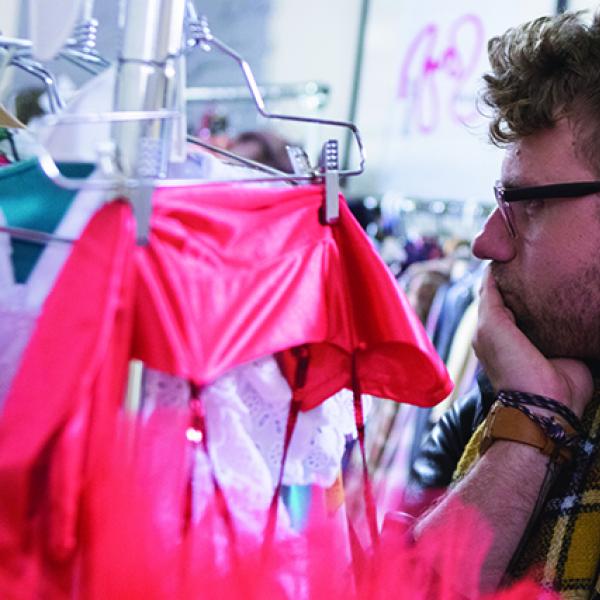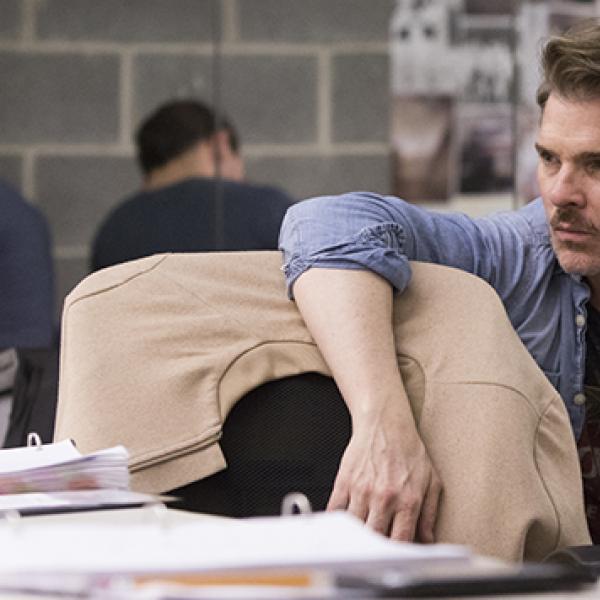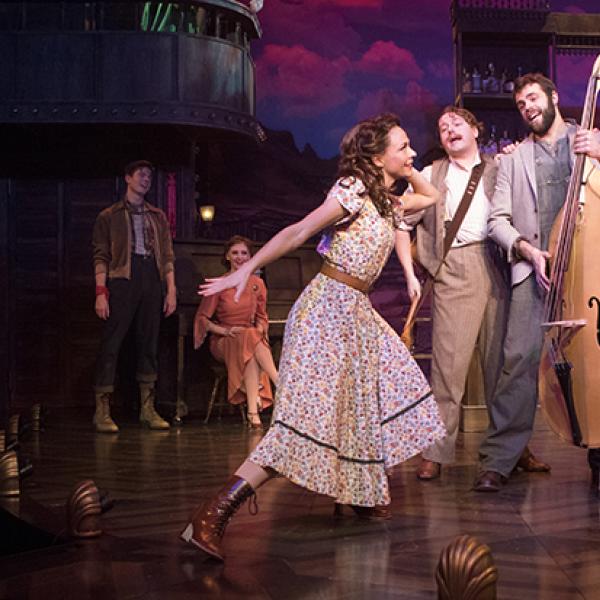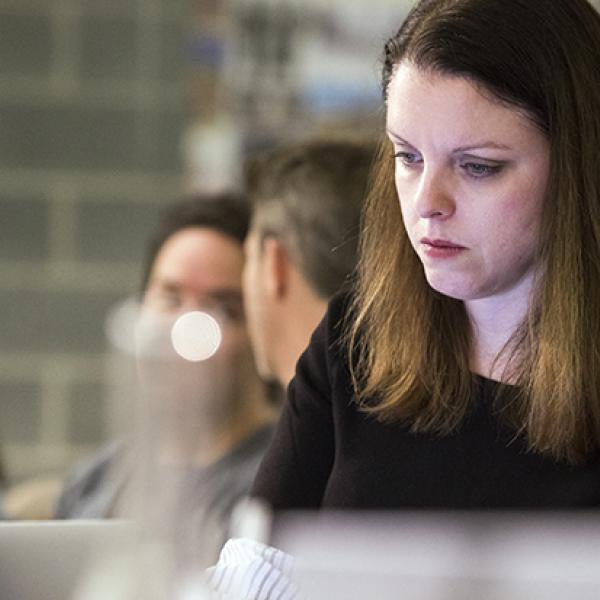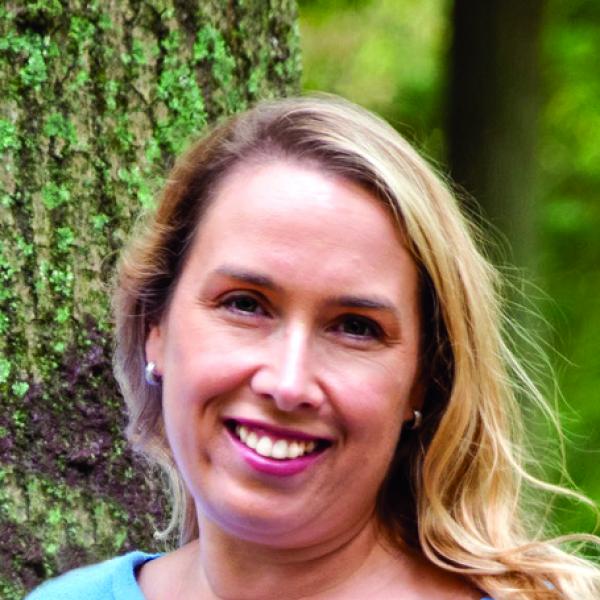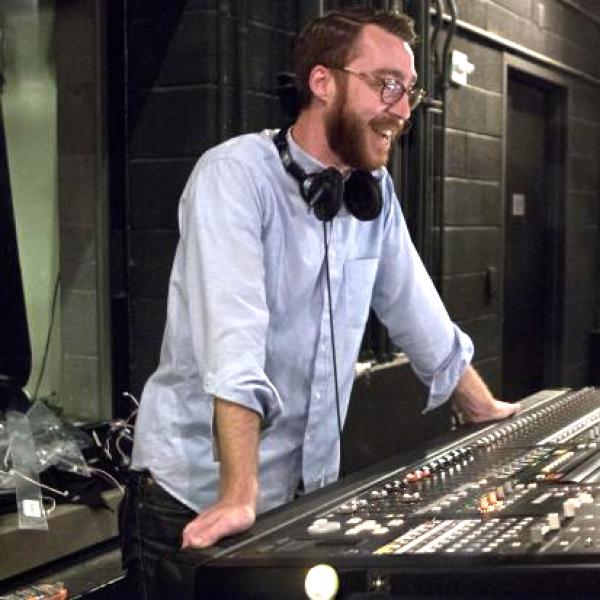Resident Music Director Jon Kalbfleisch: Transforming Musical Ideas into Reality

Resident Musical Director Jon Kalbfleisch in rehearsal. Photo by Christopher Mueller
Jon Kalbfleisch has been the resident music director of the Signature Theatre since it opened its doors in 1989. In this role, he's been at the center of the theater's creative whirlwind, and has the awards to prove it: nine Helen Hayes awards for best musical direction and 29 nominations. With Signature Theatre’s production of Crazy for You, Kalbfleisch’s ear and precision have never been more crucial. Set in the 1930s, the story moves from Broadway to Deadrock, Nevada—with songs and dances for both cowboys and chorus girls. Kalbfleisch is the man who brings all the musicians, singers, and dancers together to form a musical whole. Listen to what he does and how he does it.
Jon Kalbfleisch: My name is Jon Kalbfleisch and I’m the resident music director at Signature Theatre. If it has to do with music either sung or played it’s on the music director’s plate so you’re responsible for any musical element in the show. There’s not a minute, a lyric, a second that goes by that I am not listening to what they are singing and how they’re singing it and when they’re breathing at every second. You really have to focus like a laser on what’s going on onstage.
Jo Reed: As you just heard—that’s Signature Theatre’s music director and conductor Jon Kalbfleish and this is NEA Arts online. I’m Josephine Reed. I grew up on musical theater. I can easily sing the scores of some two dozen musicals and will at the slightest provocation. (Not that I actually can sing, but that’s another story.) So, this issue of NEA Arts with its in-depth look behind the scenes of the play Crazy for You felt like a present. And I jumped at the chance to speak to the man who is coordinating all the musical elements of this gorgeous and expansive Gershwin score….and Jon Kalbfleisch had his work cut out for him since Crazy for You clocks in with a whopping 18 plus songs.
Jon Kalbfleisch: Yes, and a whopping how many in the cast, 16, 20, 25, something like that. <laughs>
Jo Reed: And how many in the orchestra?
Jon Kalbfleisch: Fourteen in the orchestra and this is about behind the scenes, right, and the orchestra’s literally behind the scenes and so of those fourteen players many of them are playing more than one instrument and you can hear the result but you can’t see back there that the woodwinds are all playing four or five different instruments and there’s every percussion instrument you can imagine back there and two keyboards and guitar and banjo and trombones and tubas and all kinds of things so that’s a big component of it.
Jo Reed: Are you conducting?
Jon Kalbfleisch: Yeah.
Jo Reed: Oh, my Lord. You’re conducting it as well.
Jon Kalbfleisch: Yeah. That’s my favorite part. <laughs>
Jo Reed: You have all these instruments; you have all these singers. How do you make sense out of the chaos? How do you begin?
Jon Kalbfleisch: Well, you start with the score and “Crazy for You” is a little different than a lot of musicals because there’s a lot of dance music so in the case of “Crazy for You” usually music rehearsals are the first week or the first several days but for instance in “I Got Rhythm,” which ends the first act, they sing maybe five or six pages at the beginning and then they dance for twenty-five or thirty pages and then they sing one more page at the end. So there’s a lot of music that’s played that has to be well coordinated with the choreography but they’re not singing so the first thing you do is make sure all of the singing is as it needs to be and that everybody’s comfortable, which is for the soloists-- most people come in and they know it already and so you just come in and you just check and make sure everybody’s okay, but with the group stuff that has to be taught and so you have to sit down and say, “All right. Basses are singing this part, tenors are singing this part, altos are singing this part, sopranos are singing that part,” and a lot of people in musical theater don’t read music. Some people do but not everybody so you have to do it in such a way that everybody understands what’s going on and they know what they’re doing and there aren’t any questions or missing elements like that. And often in the score for a show it’ll have a chord for the chorus to sing but it doesn’t necessarily say who’s singing what note in the chord, and it’s not always as obvious that the top is the soprano and the second is the-- it’s not always that obvious ‘cause sometimes that voicing won’t work so as the music director you have to sit down and go “I got to put the guys here and the tenors there and figure out how to voice the chord” and then you teach it and then they sing it and hopefully it sounds good.
Jo Reed: I want to talk more about that collaboration with the director as well as the choreographer. I imagine you have many conversations before an actor even hits the stage or not.
Jon Kalbfleisch: It depends. Yes and no. I mean in the case of “Crazy for You” there’s so much dancing and so much choreography so he-- Denis Jones, our choreographer, was-- came up with these unbelievable sequences-- creative sequences that were different from what was originally done so there’s music that exists but he came up with things-- there’s a sequence that he-- I think he calls it the ladies’ sequence and it’s in “I Got Rhythm” at the end of the first act. And for instance a girl comes out with a nail file and he wanted her to file in a certain rhythm, which is “ch ch ch ch ch.” So we needed a musical way to represent that which wasn’t in the orchestration so what sound is it that we can hear while she’s filing her nails so that you know that she’s filing her nails and it’s meant to be an event. So in this case it’s a percussion instrument called a cabasa and he holds the cabasa right under the microphone and goes “ch ch ch ch ch” at the exact same time that she moves the nail file. So there’s lots of little things like that that are coordinated and Denis just came up with that stuff in rehearsal, decided what he wanted to do choreographically and then we met independently and he said, “I need this sound here. I need that sound there. Can you add a cymbal crash here?”, all kinds of things like that, so there’s all kinds of things that we added to the orchestration to support the choreography.
Jo Reed: Are you involved with the audition process?
Jon Kalbfleisch: Yes. In this show there’s a group, the cowboys, three guys that often sing in close harmony and they also-- the one guy plays bass and the other guy plays guitar so we needed to find out that they had the musical abilities to go along with the singing and they were right for everything else so I was particularly involved in that for this show.
Jo Reed: With somebody like the cowboys who had to sing in close harmony, you hire them individually and then hope that they can do it together?
Jon Kalbfleisch: Well, some people-- I always say Eric Schaeffer, who is one of the founders of the Signature Theatre, sees how things are going to look and he can see in his head the result and try to explain it and we don’t understand what he’s talking about but he sees it and he knows what it’s going to look like so in a similar way I can hear-- if I hear those three voices individually, I can in my head hear them together and know that it’s-- and-- or have a really good idea that it’s going to sound all right.
Jo Reed: What do you think are some of the characteristics that make for a good musical director?
Jon Kalbfleisch: Attention to detail so that everybody’s singing the right thing at the same time or at the same-- all the consonants are together and all of that stuff, during the rehearsal period, especially during a dance show a lot of patience because after the music is learned then the music goes away while they learn the choreography, which is a very slow process to teach all of that choreography and then as they get it in their bodies. So while that happens they’re not thinking about the singing and they’re not thinking about the music and nothing happens up to tempo so it’s all slow and it’s a long process and so you-- I’ve learned to be patient with the fact that I know the music is going to come back and it’s going to come back to the right tempo and feel the way it’s supposed to and the singing is going to all come back but it goes away and you have to be there and then do that. And you have to listen, and I learned this from my conducting teacher as far as how to accompany a soloist with an orchestra and I apply the same idea with the show. There’s not a minute, a lyric, a second that goes by that I am not listening to what they are singing and how they’re singing it and when they’re breathing at every second because if I am not listening for even a split second and they do something different then maybe the coordination will be off or I’ll miss something or-- so it’s-- you really have to focus like a laser on what’s going on onstage.
Jo Reed: Can you describe the rehearsal process the first day when you’re gathering everyone together?
Jon Kalbfleisch: It’s like the first day of school and still even after all these shows I can-- you can feel-- you can sense everybody’s sort of anxiety and excitement ‘cause they’re all coming and they don’t know and you don’t-- who are these people and you’ve never met them before, and maybe there’s people that you do know and you get to see friends again and-- but there’s a real sort of palpable excitement about the first day and then you come and then you meet everybody and then you realize that it’s going to be fine and good. And like I said often we start with music first ‘cause it’s easier-- if everybody learns the music first then it’s easier for them then to learn the choreography and the staging because the music has been set. If you go the other way, it’s harder to plug the music in.
Jo Reed: What’s the most challenging part for you in the rehearsal part of the process?
Jon Kalbfleisch: Well, With the Gershwin since these tunes are so popular and everybody knows them and there’s a lot of freedom in the way they can be sung-- not everybody sings them-- not even Fred Astaire sang them the same way from one show-- or movie to the next, but because of all of the dance stuff and the choreographic stuff that’s where this show was challenging was to get all of that stuff sorted out ‘cause there’s a lot of it.
Jo Reed: Now that actually leads very nicely to my next question because yes, we know all these songs so how do you as a music director make them sound fresh like they’ve never been sung before?
Jon Kalbfleisch: That’s a good question. A lot of it has to do in this case with what they did when they put this show together and created the arrangements back in the early ‘90s so they-- somebody determined we’re going to use this song and we’re going to use this much of it and this is how it’s going to play, and so it’s written in the score a certain way but basically it comes back to who’s doing the singing. Danny and Ashley in this show bring their own experience and ideas to it and so they come in and they have a way that they want to sing it and you sort of look at what the arrangement is in this particular show because there’s-- how many Gershwin shows are there? So there’s lots of different ways to sing a song so a lot of it has to do with what the actors bring and then you find what they bring and then how that jibes with what Matthew wants and what I feel like makes sense in the rest of the show.
Jo Reed:
Signature Theatre’s placement of the orchestra in the production of Crazy for You is highly unusual. It sits out of sight-- above and behind the stage. And while the arrangement does work well for the musicians, the communication between the conductor and the actors can be a bit of a challenge.
Jon Kalbfleisch: Well, in some ways for me, the musician, I have the best seat because the players are right in front of me so I’m hearing all of the great orchestral stuff front and center and then I hear the cast through a little monitor speaker that’s to my right so I’m hearing-- the difficulty here, challenge if you will, for this show particularly but it’s any show in general, is that we are behind. In a conventional theatre, there’s a pit and the musicians are there and the conductor’s there and the conductor can look right up and see them directly and so—
Jo Reed: And they can see the conductor.
Jon Kalbfleisch: Exactly, and so here there’s monitors in the back of the house that they can look up and see the conductor if they need to or want to and I see them on the monitor but I can see sort of shapes. I can’t see faces, they get washed out in the lights, so I can’t see expressions, I can’t see subtleties in movement, but I see sort of big general shapes, and then here from-- through that monitor as well and combined with all the rehearsal that we went through where I was in the room and was there when they made the decisions and saw what they were doing and felt how it was all working that all stays in my head while I’m watching through the monitor and listening to the speaker. And that’s not easy.
Jo Reed: No, that’s not easy; that sounds really complicated.
Jon Kalbfleisch: That’s not easy, yeah.
Jo Reed: It’s such an old-fashioned story--
Jon Kalbfleisch: Oh, yeah.
Jo Reed: --a completely old-fashioned story but I think the Gershwins write sophisticated music. As the music director how do you make that fit together?
Jon Kalbfleisch: Well, to me with Gershwin-- well, with any show but especially Gershwin it’s about the style. There’s a style that is characteristic of all of his stuff and the key element, which is something that I mention to the cast a lot, is the rhythm and those jazzy syncopated rhythms -- that’s not a new thing anymore but then all that pushed rhythms and syncopated stuff was new and fresh and jazzy and fun and -- I guess back to what you were saying earlier, how do you make it fresh, part of the challenge now is sometimes with singers that have been doing more contemporary stuff they’ll try to put a contemporary spin or edge on this Gershwin and it’s not necessarily the best thing so it needs to maintain the freshness of that syncopated rhythm without going too far the other way so that it sounds like it’s still Gershwin instead of Gershwin filtered through something more modern. Does that make any sense?
Jo Reed: Uh huh. It makes perfect sense actually. You’re classically trained and you still have a foot in the world of classical music. How did you come to musical theatre?
Jon Kalbfleisch: Well, I was in high school and the band director said, “You play the piano. Right?” and I said, “Yes” and he said, “Don’t you want to do the show that they’re doing in the theatre department?” I said, “What?” He said, “They’re doing a show and they need a piano player. You’ll do it. Right?” and I said, “Okay” and so that was the first one and it turned out to be fun and then did a lot of community theatre. And then I went to grad school and studied conducting so I wasn’t doing any theatre or anything else, I was in school, and so when I finished that then the opportunities-- a lot of opportunities that came were musical theatre and so that’s what I did all the while trying to do also the orchestral stuff and everything else.
Jo Reed: To say Jon Kalbfleisch is a multi-facted musician is an understatement. Aside from his multiple roles at Signature, Jon is an extremely successful classical musician. He plays the piano with the Baltimore Symphony Orchestra, is the Music Director and Organist of Capitol Hill United Methodist Church in DC. and the Music Director and Conductor of the Lawton Philharmonic Orchestra in his hometown of Lawton, Oklahoma. So what does musical theater give him that he doesn’t get from classical music
Jon Kalbfleisch: One of the things that I thought that I would really love to do although I don’t have the ability to do it is what John Williams does in writing and conducting the music to go with a film so the idea of coming up with this music that matches what’s happening in that film. So an extension of that I guess for me is the music for a show is there to support everything that’s going on in the show, this whole army of people and the crew and the-- all of this stuff but the music then is there, comes in exactly at the right time, goes out at the right time, creates the right mood, creates the right atmosphere, and it just takes care of business without coming crashing in or it-- it’s-- there’s a subtlety to it and there’s a satisfaction and everything feels good and everything’s right.
Jo Reed: That is resident music director of Arlington, Virginia’s Signature Theatre, Jon Kalbfleisch. Crazy for You is running until January 14, 2018. For NEA Arts online I’m Josephine Reed, thanks for listening.
All music is from Signature Theatre’s production of The Gershwins®’ & Ken Ludwig’s Crazy for You®,provided by and used courtesy of Signature Theatre.



